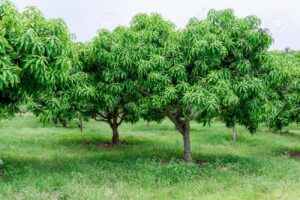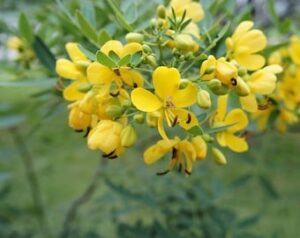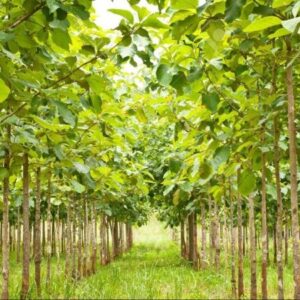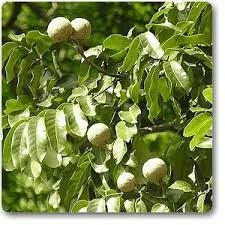I believe it is also time we promote some local products doing well in the market. This particular product has performed extremely well with different anecdotal evidence I heard. I have decided to examine the science of this product without any financial obligations to the manufacturer. I aim to promote evidence-based natural remedies.
Popularly known as ‘Policenii n’aduro no’, IMBOOST herbal mixture contains the essential raw materials that help your immune system resist diseases and repair worn-out tissues. IMBOOST Herbal Mixture is locally produced from Mangifera indica, Khaya senegaliensis, cassia siamia, and Tectona grandis. This article examines the scientific aspects of the ingredients.
IMBOOST – Science
Mangifera indica

Two studies (Batool et al. 2018; Zhang et al. 2019) confirmed that the leaves of Mangifera indica have been used in Ayurveda and traditional Chinese medicine for many years in naturopathic healing. Zhang et al. (2019 ) explained that the leaves especially have been used in naturopathic practices to treat diabetes and many other health conditions, as compared to other parts such as the stem, bark, roots and fruit.
Mangifera indica – science
Loaded in plant compounds
One study by Ediriweera et al.(2017) found that the leaves of mango are loaded with diverse significant plant compounds, such as polyphenols and terpenoids. One such is Terpenoids, which another study by Grassmann, J(2005) found is good for eye health and immunity. Terpenoids also act as antioxidants, which protect our cells from harmful activities.
Two other studies( Fraga et al. 2019; Cory et al. 2018) also found that the polyphenols in Mangifera indica are also loaded with antioxidant and anti-inflammatory properties. These polyphenols enhance gut bacteria and help treat or prevent conditions like obesity, diabetes, heart disease and cancer.
One specific polyphenol found in Mangifera indica, called mangiferin, is linked with several health benefits (Du et al. 2018; Matkowski et al. 2013; Barreto et al. 2008). For instance, Du et al. (2018) found that mangiferin acts as an anti-microbial agent and potential treatment for tumors, diabetes, heart disease, and fat digestion abnormalities though more human studies are needed ( Batool et al. 2018).
Mangifera indica – anti-inflammatory properties
Although more human studies are needed, three studies have demonstrated the potential anti-inflammatory properties in mango leaves ( Saha et al. 2016; Pan et al. 2016; Fomenko and Chi, 2016). Although inflammation is part of the body’s normal immune response, chronic inflammation can increase the risk of various diseases.
However, this can be dealt with by using mango leaves. One animal study ( Omairi et al. 2018) found that mango leaves’ anti-inflammatory properties could protect the brain from conditions like Alzheimer’s or Parkinson’s. In this study, a mango leaf extract given to rats at 2.3 mg per pound of body weight (5 mg per kg) helped counteract artificially induced oxidative and inflammatory biomarkers in the brain.
Mangifera indica – weight loss
One study by Zhang et al.( 2013) found that the mango leaf extract could manage obesity, diabetes and metabolic syndrome by interfering with fat metabolism. Additionally, three other animal studies (Zhang et al. 2013; Guo et al. 2011; Sferrazzo et al. 2019) have found that the mango leaf extract inhibits fat accumulation in tissue cells. The studies further found that cells treated with a mango leaf extract had lower levels of fat deposits and higher levels of adiponectin.
Two studies (Nigro et al. 2014; Achari and Jain, 2017) explained that adiponectin is a cell-signalling protein that plays a role in fat metabolism and sugar regulation in the body. Higher levels could protect against obesity and obesity-related chronic diseases. In another study of rats ( Ramírez et al. 2017) who were obese, those fed mango leaf tea in addition to a high-fat diet had less abdominal fat as compared to those given only the high-fat diet.
In another study, which happens to be in humans ( Na et al. 2015) conducted for 12 weeks in 97 adults with excess weight, those given 150 mg of mangiferin daily had lower fat levels in their blood and better insulin resistance index as compared to the placebo. This means that mango leaves are better for blood sugar management.
Mangifera indica – blood sugar, blood pressure management
Studies have confirmed that mango leaves have a better score in the management of blood sugar due to their effects on fat metabolism. For instance, Zhang et al. (2019) study used the mango leaf extract administered to mice for 2 weeks, and found that it has lower triglyceride and blood sugar levels.
Another study in rats by Sandoval-Gallegos et al. (2018) administered 45 mg per pound of body weight (100 mg per kg) of mango leaf extract and found that it decreased hyperlipidemia, a condition characterised by abnormally high levels of triglycerides and cholesterol.
A recent animal study by Boas et al. (2020), this time, compared mango leaf extract and the oral diabetes drug glibenclamide in rats with diabetes. The study found that the mango leaf extract group experienced lower blood sugar levels than the glibenclamide group after 2 weeks. A previous human study (Evans et al. 2014) from Oklahoma found that individuals are given mango leaf extract and fruit for 12 weeks drastically decreased blood sugar levels in obese adults. Finally, another previous study (Lattimer and Haub, 2010) found that its fibre content promotes normal blood sugar levels.
With high blood pressure, one study (Houston and Harper, 2008) found that mango is loaded with high magnesium and potassium, which are two essential nutrients that are vital when it comes to regulating blood pressure. Additionally, Ha. SK (2014) also reports that Mangifera is naturally low in sodium, a micronutrient that should be limited in those with high blood pressure.
Mangifera indica, cancer properties
Two reviews (Vyas et al. 2012; Khurana et al. 2016) found that mangiferin in mango leaves may have an anti-cancer ability as it combats oxidative stress and fights inflammation. One test-tube study by Núñez Selles et al. (2016) found specific effects against leukemia and lung, brain, breast, cervix and prostate cancers.
An earlier study (Youn et al. 2008) found that the mango bark has strong anti-cancer ability due to its lignans, which are another type of polyphenol. Additionally, one significant study by Glinskya and Razc (2009) found mangoes to be loaded with pectin. These pectins, which aid to lower cholesterol levels in the blood could also fight prostate cancer – in vitro studies.
Another good news for men is that a compound within pectin combines with galectin-3, a protein that is pivotal in fighting inflammation and cancer progression. For instance, an old human study by Daviglus et al (1996) found that higher dietary intakes of vitamin C and beta-carotene, an antioxidant found within mango, increased survival rates in men with prostate cancer. This means that IMBOOST could help men diagnosed with prostate cancer improve their quality of life(QOL).
Finally, another in vitro study by Wilkinson et al.(2011) conducted by the University of Queensland also established that extracts of mango flesh and peels were effective at blocking the growth of breast cancer cells. This also suggests that IMBOOST formulated in Ghana with mango extract could be integrated into the natural cancer treatment protocol.
Mango – stomach ulcers, digestive health
Although human studies are limited in this area, some studies (Prabhu and Rajan, 2015; Priya et al. 2011; Lima et al. 2006) found that mango leaves and other parts of the plant have traditionally been employed in naturopathic practice to treat stomach ulcers and other digestive conditions.
Also, one study in rodents (Severi et al. 2009) found that orally administering the mango leaf extract at 113–454 mg per pound (250–1,000 mg per kg) of body weight reduced the number of stomach wounds. Another earlier rodent study (Carvalho et al. 2007) found the same findings, with mangiferin drastically improving digestive damage. The fibre in mango, (Anderson et al. 2009; Anderson et al. 2009) has been found to add bulk to the stool to increase stool frequency in people with constipation, and also helps protect against other gastrointestinal conditions, including haemorrhoids, GERD, intestinal ulcers and diverticulitis.
Mango – healthy skin, hair
A recent study by Zhang and Duan (2018) found that mango leaf extract could decrease signs of skin ageing due to its antioxidant content. Another earlier study in mice( Song et al. 2013) found that mango extract taken orally at 45 mg per pound (100 mg per kg) of body weight increased collagen production and drastically shortened the length of skin wrinkles.
Another test-tube study by Chirayath et al.( 2019) found that the mango leaf extract could have antibacterial effects against Staphylococcus aureus, a bacterium that can cause staph infections. In a recent study by Pleguezuelos-Villa et al. (2020) the mangiferin in mango has also been studied for psoriasis – a skin condition that causes itchy, dry patches. A test-tube study using human skin confirmed that this polyphenol encouraged wound healing.
On hair, three studies( Laulloo et al. 2018; Trüeb et al. 2009; Trüeb et al. 2015) confirmed that mango leaves are rich in antioxidants, and protect hair follicles from damage. This aids hair growth.
Mango – asthma
Senaidy, AM (2009) found high level of vitamin A and beta-carotene, hence, could have some impact on allergic diseases, such as asthma.

Siamea has been reported to be used in the management of constipation, diabetes, insomnia, hypertension, asthma, typhoid fever and dieresis. Leaves and bark of medicinal plants were reported to be used locally as anti-malarial medications.
Siamia – analgesic
One study by Ntandou et al.(2010) investigates the analgesic and anti-inflammatory activities of cassia siamea lam stem and bark extracts. The study found that siamia has analgesic and anti-inflammatory properties. The study also noted that the analgesic and anti-inflammatory properties are derived from the following compounds present in the plant: triterpenes (lupeol, oleanolic acid, ursolic acid, friedelin, betulin), flavonoids (apigenin, kaempferol, luteolin), anthraquinones (emodin), phytosterols (stigmasterol, beta-sitosterol).
Siamia – long life
One study on common fruit fly by Wongchum and Dechakhamphu (2021) examined the claim of longevity, and found that eating a diet that contains siamia could significantly extend the mean life span of the common fruit fly by 14percent compared with the control diet. The study provides supportive evidence that supplementation with siamia prolonged the life span and reduced oxidative stress in the common fruit fly. Though this is an animal study, it provides the clue that taking IMBOOST as a supplemental diet could be supporting your age.
Cassia Siamia – a natural dewormer
One study examined cassia siamia as a natural dewormer with the pharmaceutical drug Ivermectin as a control. The study found that cassia siamea may be used as a natural source of lead compounds for the development of alternative anthelmintic.
Cassia siamia – antimalarial
One study by Tasiam et al.(2020) examined cassia siamia as an antimalarial drug and found that cassia Siamia demonstrates the requirements of a promising anti-malarial effect.
Cassia siamia – antioxidant
One study by Kaur et al.(2006) suggests that the alcoholic extract of C. siamea flowers has potent antioxidant activity against free radicals, prevents oxidative damage to major biomolecules, and affords significant protection against oxidative damage in the liver.
Tectonia grandis
Tectona grandis, commonly known as teak, is a tall deciduous tree that typically grows to 150′ tall in its native habitat, but to about 80′ in cultivation. It is native to India, Myanmar (Burma), Southeast Asia, Malaysia, and Indonesia, but is n

ow planted in tropical to sub-tropical areas throughout the globe, not only for ornamental reasons but also in plantations for commercial timber production. Timber from this tree is an important tropical wood -at or near the top of the list of world hardwoods.
Unfortunately, demand for teak timber has far outpaced available supply, with the result that many of the old teak forests from native habitat areas have now been decimated by overlogging. Even though the demand for teak wood remains unmet, commercial plantations help meet that demand in a way that does not harm natural plantings which in many areas are still subject to logging.
Teak trees feature: (a) trunks with scaly gray to gray-brown bark topped by an open crown of spreading branches, (b) large, rough, leathery, ovate-elliptic, green leaves (to 18-30″ long) which are covered by gray-green stellate hairs, (c) fragrant, finely-pubescent, white flowers which bloom in summer (June-August) in large terminal panicles to 16″ long, (d) globose, finely pubescent fruits (to 2/3″ diameter) enclosed in egg-shaped calyxes which mature from September to December, and (e) dark yellow trunk wood which turns an attractive deep brown when exposed to sunlight and air.
Teak wood is hard, durable, fine-grained, resistant to decay if exposed to moisture, and of attractive deep brown colour. Teak wood is used in a variety of ways, including: (a) for outdoor purposes, it is used in the manufacture of outdoor furniture, boat building, doors, and window frames; and (b) for indoor purposes, it is used for flooring, fine furniture, and veneer. Teak is the national tree of Indonesia.
Leaves of the teak wood tree are used in making Pellakai gatti (jackfruit dumpling), where a batter is poured into a teak leaf and steamed. This type of usage is found in the coastal district of Udupi in the Tulunadu region in South India. The leaves are also used in gudeg, a dish of young jackfruit made in Central Java, Indonesia, and give the dish its dark brown colour.

Medicinally, it is used for tonic and fever medicine; a chewing stick for treating toothaches, dental caries, and septic mouth as well as treating diarrhoea, dysentery and malaria. In most parts of West Africa, the bark is used against fever and malaria; hence, it has been described as African quinine. (Atawodi et al. 2003; Wurochekke and Nok,2004 ; Mikail, 2009; Aderbauer et al 2008; Umar et al, 2010; Adeiza et al. 2010; Ibrahim et al, 2008; and Ibrahim et al 2013) investigate extracts of stem bark both in vitro and in vivo in rats, against T. evansi, T. congolense and T. b. brucei. All showed promising results and a few demonstrated an effective dose.
Wood is used for a variety of purposes. It is often used conventionally for carpentry, interior trim, and construction. Traditionally the wood was used for dugout canoes, household implements, djembe, and fuel wood. The bitter-tasting bark is used for a variety of medical purposes; it is taken against fever caused by malaria, stomach complaints, and headaches. It is applied externally to cure skin rashes, wounds, or any abnormality. It has been exported from West Africa (Gambia) to Europe since the first half of the 19th century and has been exploited heavily for its timber. It is now used more locally and is planted ornamentally as a roadside tree.
Take Home
Animal studies have demonstrated the many benefits of the ingredients used in formulating IMBOOST Herbal Mixture. Some have demonstrated its effects on immunity, others as a natural dewormer, anti-inflammatory and many others.
>>>The author is a Professor of Naturopathic Healthcare and President of Nyarkotey College of Holistic Medicine & Technology (NUCHMT)/African Naturopathic Foundation.
References
- Nsonde Ntandou GF, Banzouzi JT, Mbatchi B, Elion-Itou RD, Etou-Ossibi AW, Ramos S, Benoit-Vical F, Abena AA, Ouamba JM. Analgesic and anti-inflammatory effects of Cassia siamea Lam. stem bark extracts. J Ethnopharmacol. 2010 Jan 8;127(1):108-11. doi: 10.1016/j.jep.2009.09.040. Epub 2009 Sep 30. PMID: 19799981.
- Wongchum N, Dechakhamphu A. Ethanol extract of Cassia siamea increases life span in Drosophila melanogaster. Biochem Biophys Rep. 2021 Jan 26;25:100925. doi: 10.1016/j.bbrep.2021.100925. PMID: 33553687; PMCID: PMC7844133.
- Tasiam E, Primaharinastiti R, Ekasari W. IN VITROANTIMALARIAL ACTIVITY AND TOXICITY STUDIES OF JOHAR (CASSIA SIAMEA) LEAVES FROM THREE DIFFERENT LOCATIONS. Afr J Infect Dis. 2020 Jul 31;14(2):23-29. doi: 10.21010/ajid.v14i2.4. PMID: 33884347; PMCID: PMC8047291.
- Kaur G, Alam MS, Jabbar Z, Javed K, Athar M. Evaluation of antioxidant activity of Cassia siamea flowers. J Ethnopharmacol. 2006 Dec 6;108(3):340-8. doi: 10.1016/j.jep.2006.05.021. Epub 2006 Jun 12. PMID: 16846707.










